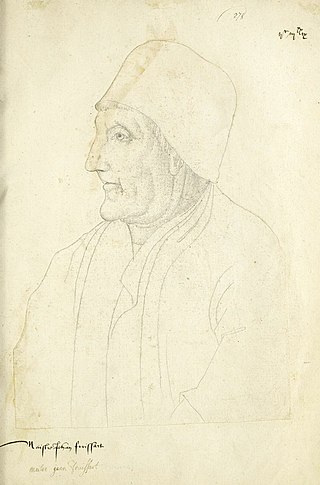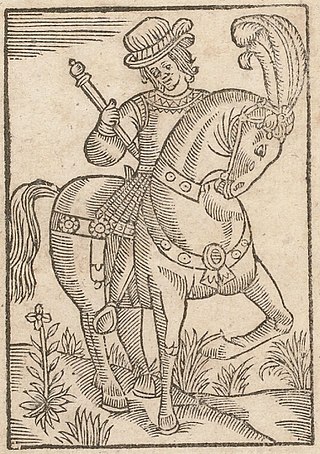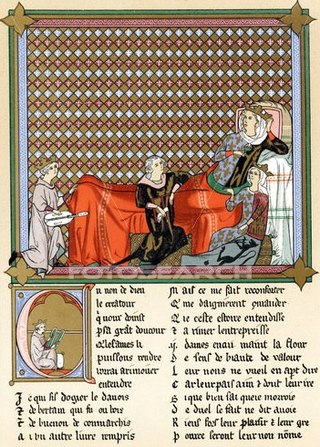Related Research Articles

Jean Froissart was a French-speaking medieval author and court historian from the Low Countries who wrote several works, including Chronicles and Meliador, a long Arthurian romance, and a large body of poetry, both short lyrical forms as well as longer narrative poems. For centuries, Froissart's Chronicles have been recognised as the chief expression of the chivalric revival of the 14th-century kingdoms of England, France and Scotland. His history is also an important source for the first half of the Hundred Years' War.

Georges Cadoudal, sometimes called simply Georges, was a Breton politician, and leader of the Chouannerie during the French Revolution. He was posthumously named a Marshal of France in 1814 by the reinstated Bourbons. Cadoudal means in Breton language "warrior returning from the fight".

Enguerrand de Monstrelet was a French chronicler. He was born in Picardy, most likely into a family of the minor nobility.

François Just Marie Raynouard was a French dramatist and linguist.

Guillaume du Vair was a French author and lawyer.

Guillaume Amfrye de Chaulieu, French poet and wit, was born at Fontenay, Normandy.

Guillaume de Palerme is a French romance poem, later translated into English where it is also known as William and the Werewolf. The French verse romance was composed c. 1200, commissioned by Countess Yolande. The prose version of the French romance, printed by N Bonfons, passed through several editions.
Guillaume de Nogaret was a French statesman, councillor and keeper of the seal to Philip IV of France.

Jean-Baptiste Claude Eugène Guillaume was a French sculptor.
Jean de Meun was a French author best known for his continuation of the Roman de la Rose.

The Archdiocese of Paris is a Latin Church ecclesiastical jurisdiction or archdiocese of the Catholic Church in France. It is one of twenty-three archdioceses in France. The original diocese is traditionally thought to have been created in the 3rd century by St. Denis and corresponded with the Civitas Parisiorum; it was elevated to an archdiocese on October 20, 1622. Before that date the bishops were suffragan to the archbishops of Sens.
Benoît de Sainte-Maure was a 12th-century French poet, most probably from Sainte-Maure-de-Touraine near Tours, France. The Plantagenets' administrative center was located in Chinon, west of Tours.
William the Breton, French chronicler and poet, was a contemporary and dependent of French king Philip Augustus for whom he served in diplomatic missions and for whom he wrote a Latin prose chronicle and a Latin epic poem.

Adenes le Roi, was a French minstrel or trouvère. He was a favourite of Henry III, duke of Brabant, and he remained at court for some time after the death of his patron in 1261.
La Geste de Garin de Monglane is the second cycle of the three great cycles of chansons de geste created in the early days of the genre. It centres on Garin de Monglane. One of its main characters is William of Gellone.
Conon de Béthune was a French crusader and trouvère poet who became a senior official and finally regent of the Latin Empire of Constantinople. Alternative spellings of his name include Cono, Coesnes, Quenes, Conain, and Quenon.
Guillaume de Nangis, also known as William of Nangis, was a French chronicler.
Nationality words link to articles with information on the nation's poetry or literature.
The House of Bethune is a French noble house from the province of Artois in the north of France whose proven filiation dates back to Guillaume de Béthune who made his will in 1213. This family became extinct in 1807 with Maximilien-Alexandre de Béthune, duke of Sully.

Antoinette Du Ligier de la Garde Deshoulières was a French poet.
References
- 1 2 3 Chisholm 1911.
Attribution:
- This article incorporates text from a publication now in the public domain : Chisholm, Hugh, ed. (1911). "Guiart, Guillaume". Encyclopædia Britannica . Vol. 12 (11th ed.). Cambridge University Press. p. 683.; endnotes:
- See A. Molinier, Les Sources de l'histoire de France, tome iii. (Paris, 1903).